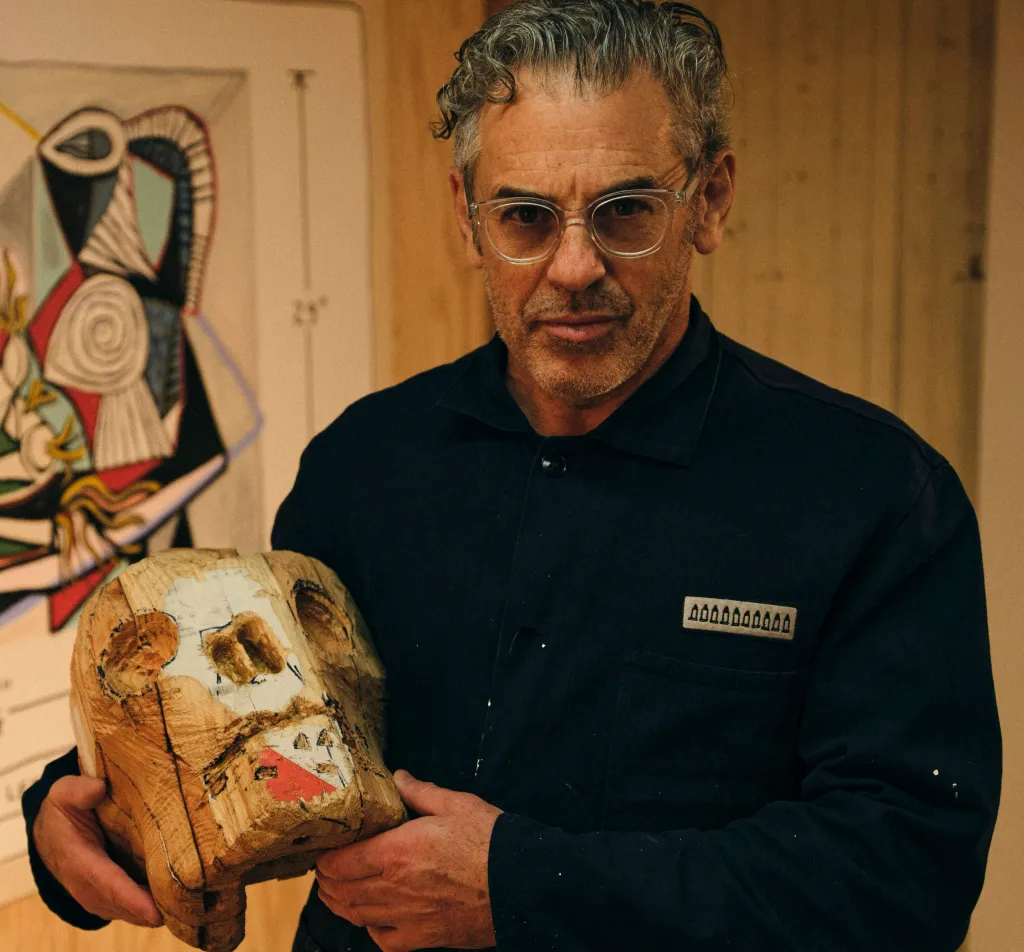American artist Tom Sachs was dishing out espressos and 86-proof mezcal from behind a bar at Thaddaeus Ropac’s gallery on Dover Street during Frieze Week. He was launching his new show, “A Good Shelf” (it runs until December 20), featuring 30 NASA-emblazoned ceramics inspired by Japanese tea bowls (chawans), ritual, bricolage, and space travel. Sachs deserved a stiff drink after a testing couple of years; his sneaker-release partnership with Nike was paused in 2023 following allegations that he created a “hostile and unduly strict” workplace in his New York studio. Nike pressed play again last February and Sachs, who vowed to improve working conditions, is back at the coalface, toiling as intensely as ever.
He’s completed several international projects over the last few months, including another exhibition at Ropac’s Seoul outpost scrutinizing Pablo Picasso.
Only a handful of living artists have reached the heady heights of commanding a studio team realizing ambitious, large-scale visions. Sachs, 59, whose auction record stands at $302,400 for his Tiffany Value Meal (1998) at Christie’s, is one of them. His work includes a life-size replica of the Apollo lunar excursion module for his “Space Program” series, a Chanel-branded guillotine (Chanel Guillotine [Breakfast Nook], 1998), and a 17-foot-long foamcore sculpture titled Unité (2001). The latter is a commentary on the commercialization of high modernism and holds court in the Guggenheim’s permanent collection. His current show at Ropac is a continuation of his 2012 “Space Program: Mars Mission” show, when he created a bricolage version of the traditional Japanese tea ceremony to be conducted on the red planet.
“A Good Shelf’s” hand-formed ceramics symbolize Sachs’s pursuit of perfection, the juxtaposition of balancing control with intuition, and relinquishing his artistic identity. “Ceramics, without doubt, is the most complex of all crafts,” he told ARTnews. “At almost 60 years old, I’ve dabbled in every possible craft. Ceramics is the most technically advanced. It involves the most error, science, and chemistry. In my hand-building, I’m always striving toward my ideal, who is the 16th-century potter Chōjirō, the founder of Raku-ware [a type of Japanese pottery traditionally used in Japanese tea ceremonies]. As I get better, I’m giving up my character, because my ceramics are losing some of the identity and crappiness of being made by an individual.”
Each unique ceramic in the exhibition is embossed with “NASA” and the fingerprints of its maker. They’re deeply personal as a result and displayed on shelves made from rough fragments of materials like cinderblock, polystyrene, and plywood. Sachs described himself as a “blackbelt in bricolage.”
I asked him if he’s ever found perfection in his sculpture-based practice. “Yeah, I think that I have found a level of mastery in many areas, like when I make models or sculptures of pre-existing things in the wrong material and the wrong scale,” he said. “Whether that’s a Hermès Kelly bag or a lunar module, I found a way that is authentically mine, a way that makes it look like it was made in a factory despite being made by hand. I think the language of sculpture I’ve developed over the last 40 years in well established, whereas with ceramics, I’m still learning and struggling, but through repetitive work, innovation happens accidentally.”
The element of ritual evident in “A Good Shelf” is important for Sachs, who said “one of my daily rituals is to make a new ceramic every morning before I check my phone.” He added that it distracts him from the daily grind of the digital world and fuels his creativity, a vital channel for a self-confessed utilitarian obsessed with function and purpose.
When I asked him if his fixation on utility ever limited his artistic flow, he thought for a minute before replying: “In the studio, we say, ‘creativity is the enemy,’ and I mean that quite seriously. It’s like chilli pepper, you don’t need a lot of it to give spice to what you’re doing, and too much just ruins the sauce. You need a high percentage of pure hard, of just showing up every day. And then, in the 99 percent of the time you spend making a sculpture or digging a ditch, the mind wanders, yet it is anchored through the action of work. And work becomes like a meditation, and this is when innovation and accident occur, like genetic mutations in nature. It’s mostly the same animal being reproduced generation after generation, yet genetic changes occur through accident that give it a better chance of survival. That’s how slime evolved over billions of years into creatures that discuss slime. Creativity is about sticking with your guns and spending a lot of time at the table.”
